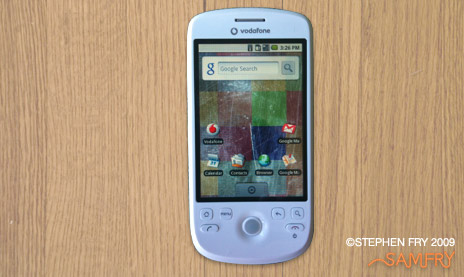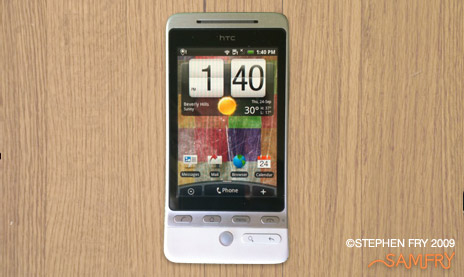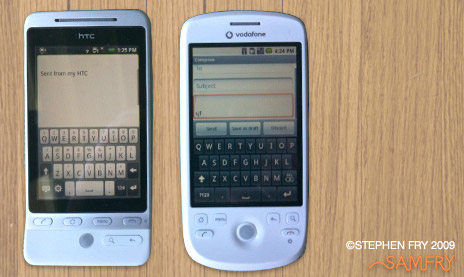Android
Android is the name given to an open source mobile operating system developed by Google and the Open Handset Alliance and released a year ago. In December 2008 I reviewed here the HTC G1, the first android phone. I concluded:
One can bet that the G2 and G3 will better bear the luscious fruit of Open Source development before very long. Meanwhile, the G1 stands as a reasonably priced and impressive first shot from HTC and Android. The whole system can only improve and when it does it will truly give the iPhone a run for its money. Especially if Apple stays as tightly closed as they are now.
Well Apple haven’t shown much sign of opening up. Each week seems to bring a new story of some indignant developer complaining at Apple’s lordly refusal to allow their new app shelf-space in the store. Even the mighty Google have been whingeing. On the other hand Apple have not stood still in the field of iPhone development either. So have Android and HTC managed to close the gap with the Hero and the Magic?
Magic
The Magic first. Exclusive to Vodafone in the UK, this sleek little device houses the new (Cupcake) 1.5 Android firmware. Much is recognisable from the G1, and while much has also been greatly improved only a few of my earlier gripes have been addressed. There is now a videocamera and video playing built in from the get-go and that must be good. Still no standard audio jack however, which is close to a criminal offence these days. The set of ear-plugs HTC provides for attachment to the miniUSB port are tinnier than a 60s portable transistor radio playing Aha hits in a zinc-roofed hut with the treble up to 11. No PC or Mac synchronisation, no MS Exchange capability, no multitouch and still a noticeable lag when the screen is oriented from portrait to landscape and vice versa.
So how is the Magic different from the G1? Well, the most striking and obvious difference is the lack of a slidey-outy keyboard. This is a very weird development in the world of Android. Many of my friends still give the iPhone’s lack of a physical keyboard as their crowning reason for staying with their BlackBerries and I freely confess that I was one who at first deprecated the iPhone’s onscreen virtual keyboard, finding text input slower for my fingers than either a BlackBerry or Palm Treo. I am now dining on humble pie (if in England), or on crow (if in America) – for I must confess that, steepish as the learning curve may have been, I am these days quicker on an iPhone than on any physical phone keyboard I know. There are still moments of agonising frustration — especially when typig like this and missig the ‘n’ which for some reason happens a lot, as does, conversely, hitting the ‘n’ insteadnofnthenspacebar. Then there’s the mysterious case of the cursor inexplicably dropping down to the bottom of the screen while typing. The fact that the autocorrect glossary is not user-editable means that all kinds of words are now understood to be acceptable to the iPhone’s internal autocorrect mechanism and … well, I could go for ever. The point is, Google, OHA, HTC and their advocates could scarce forbear to gloat when the G1 was announced to be the proud bearer of a hinged slidey-outy keyboard. “That’ll put the iPhone in its place,” they cheered as one. “Steve Jobs laid on egg with his refusal to allow a proper keyboard. We’ll show him.” The keyboard was the G1 hardware’s Unique Selling Point and already, with their first makeover it’s gone, to be replaced by as close a simulacrum of Apple’s own VKB as they could contrive without being taken to court for patent infringement.
They have done the right thing, humiliating as the climb-down might be. In landscape mode especially, one can type very quickly (though still the same propensity to missthespacebarthatdogstheiPhone – maybe it’s just the way I type). A highly satisfactory strip above the keyboard presents one-touch options to the words you’ve typed. If you’re Android savvy and know your way around the bay a bit, you can replace the design of virtual keyboard that comes with the Magic with its much improved successor, as seen in the Hero (see below). You’ll need to download the Android SDK and a few other programmes to your desktop computer, but it can be done. If you’re allergic to terminal mode and entering commands like chmod bin/sh usr ${VAR} then wait for a firmware upgrade and leave well alone.
The lack of a hinged PKB contributes of course to the Magic’s light simple and shiny unibody shape and feel. The merest hint remains of the endearingly grotesque ‘chin’ that angled out from the lower section of its ancestor, the G1. My model, as you can see, is white and is branded Vodafone. Only the volume rockers and miniUSB port break up the purity of the wraparound – there is a place for microSD cards but that is safely tucked away under the easily removable lid where the (replaceable) battery and SIM card also live.

The inbuilt GPS wireless, which is demanding on the battery, seems to respond much, much quicker than it did on the G1 and the addition of a compass means that true turn-by-turn satnav is a real possibility, and I note that one or two (rather ungenerously user-reviewed) navigation apps are starting to hit the Market. HTC’s trademark haptic vibration allows a pleasurably tactile feedback which I really like and which would benefit the iPhone enormously.
The camera on the reverse side offers a 3.2 MP flashless sensor which delivers perfectly adequate pictures in a good light, but which – as does the iPhone – struggles in murkier conditions. These days we routinely hand our phones to a friend, waiter or passer-by so that we can be in the photo ourselves. On the iPhone that helpful passer-by will often press the home button instead of the picture button, causing one to have to come round and give a lesson, which is all very vexing and time-consuming. The happy-snap mood will have been dispelled and the moment gone. This isn’t a problem on the Magic, where the photo button to touch is clear and unambiguous. Once taken, there is an intuitive row of buttons which offer sharing and saving options – straight to Twitter, Picasa (not Flickr – this is a Google phone, remember), wallpaper, email, messaging or home gallery. Unless I’m being very stupid there is no way to switch between still and video modes for the camera without quitting, returning to the home screen and choosing the dedicated videocamera app, which seems a little silly. The quality of video is not going to threaten even the old Flip style devices, let alone the new generation of HD recorders, but it’s fine for rough and ready use and footage can (naturally) be uploaded straight to YouTube.
For anyone used to the iPhone 3GS (where “S” stands for Speed) the Magic seems slow. General functions, application opening and accelerometer screen orientation are all a little laggardly, the price paid for using last year’s chipset, I suppose.
Otherwise everything one might expect is present: I ought to point out that this phone is really of no use to anyone who doesn’t have a Google account. Yes the mail client can deal with non Gmail accounts, yes, some form of Outlook synchronisation is possible and yes too, you can download a variety of chat clients from the Apps Market, but the straight-out-of-the-box preference is for Google Calendars, Contacts, Mail and Talk. It may be technically a Vodafone badged HTC Magic, but to all intents and purposes it’s G2, Le Googlephone Deux.
Final judgment. Better than the G1, the very light, slim Magic is an excellent 3G device for the money (free) but still with annoying niggles. It’s packed with the GPS, compass, bluetooth, wi-fi and all you’d expect from a classy modern touchscreen smartphone. The interface is customisable but not daunting, simple yet powerful. It comes with a Vodafone contract that will keep you locked in for 18 months, by which time many better phones will have come and gone, so make sure there’s a free or very affordable hardware upgrade path available to you from Vodafone during the term of your deal.
Hero
Which brings us to the Hero, our second Android 1.5 Cupcake Google phone from those Taiwanese wonders, HTC. At first glance you might think it a reversion, for it looks a little closer to the G1 than the Magic, having almost as prominent a chin and a more matte finish. But look closer, there are changes, and they are all for the better. The screen has that oleophobic, fingerprint-repelling coating first encountered on the iPhone 3GS. The body (in the white version at least) is teflon coated. And whoopy-doo! – do my eyes deceive me? – a standard audio jack for attaching proper headphones! And wowzerooni! – a 5.0 Mp f2.8 autofocus camera. They’ve been listening. So, what about activating that grease-resistant screen and seeing what awaits within….

Hello there! – a calendar and weather widget welcome you to the home screen and an all new virtual keyboard offers better visual (and buzzy-haptic) feedback and a neat achievement of Shift characters by a simple press and hold. A suite of themes called “scenes” allow cookie-cutter or customisable wallpapers and environments. The idea is to switch between work and leisure or home and travel, devising different environments for your week and weekend for example. HTC calls this new system “Sense” and while it will last no longer in the world than “Flow” or any of their previous graphic user interfaces, it does very well for this phone, which is (aside from the camera and audio-jack) identical under the hood to the Magic and (under) powered by the same 528 MHz processor and (under) equipped with the same 288MB of RAM.
HTC have essentially taken over the Android stage and redressed it with their own sets, props and costumes, in much the same way they did two years back with the horror that was Windows Mobile. Android needs less disguising than WinMob did, but nonetheless you have to applaud HTC, they have gone all out to rethink every detail of the user experience. The superb standard Android notifications blind that pulls down from the top of the screen has wisely been kept, but HTC offer their own Mail client for the Magic, one which finally allows Exchange and all the flavours if IMAP and POP that you need if you don’t have a Gmail account, and they have a tweaked version of the webkit browser, which is now Flash enabled, though don’t expect to be able to play YouTube or Vimeo footage, in fact I could barely find anything other than a few website splashscreens that could show this implementation off. The browser also now offers true iPhone style multitouch spreading and pinching instead of tedious + and – zoom buttons. Twitter and Facebook have been integrated into HTC’s new environment too, should you want it both services can be now always on and just a swiped screen away.
Naturally, all this threaded function and all these fancy widgets and themes come at the cost of overtaxing the engine. If the Hero were faster and smoother you could call it a real pretender to the iThrone, but the continued sluggishness and ongoing difficulties with syncing media to and from PC or Mac do hold it back. At least so I thought until this afternoon when I downloaded the new 2.73 ROM upgrade which is available from the HTC site – my thanks to readers who alerted me to this. It makes a real difference to the three crucial S’s in this arena — smoothness, speed and stability.
It’s an impressive device, really really impressive. One is bound to ask why Vodafone UK, in seeking to offer an Android phone, chose the Magic over this clearly superior version. Perhaps the Magic is cheaper, perhaps HTC demand a premium for all the work they have put into their beautifully pimped Hero.

Android has done well in its first year. Its staunchest advocate cannot pretend that it is a success story on a par with that of the Apple iPhone, but 10,000 apps in the Android Market (to Apple’s 85,000) shows that there is a solid and committed developer community catering for a satisfied and enthusiastic user base. The Hero will make sure both groups will continue to grow.
Around the corner lurk the launches of the Motorola Cliq and rumoured Android phones from Samsung and LG: these can only help ensure that Google’s Open Source OS is here to stay.
Coming soon
Early autumn is BlackBerry picking time…




